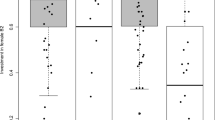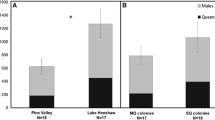Abstract
Small societies of totipotent individuals are good systems in which to study the costs and benefits of group living that are central to the origin and maintenance of eusociality. For instance, in eusocial halictid bees, some females remain in their natal nest to help rear the next brood. Why do helpers stay in the nest? Do they really help, and if yes, is their contribution large enough to voluntarily forfeit direct reproduction? Here, we estimate the impact of helpers on colony survival and productivity in the sweat bee Halictus scabiosae. The number of helpers was positively associated with colony survival and productivity. Colonies from which we experimentally removed one helper produced significantly fewer offspring. However, the effect of helper removal was very small, on average. From the removal experiment, we estimated that one helper increased colony productivity by 0.72 additional offspring in colonies with one to three helpers, while the increase was smaller and not statistically significant in larger colonies. We conclude that helpers do actually help in this primitively eusocial bee, particularly in small colonies. However, the resulting increase in colony productivity is low, which suggests that helpers may be constrained in their role or may attempt to reproduce.



Similar content being viewed by others
References
Alexander RD (1974) The evolution of social behavior. Annu Rev Ecol Syst 5:325–383
Barclay P, Reeve HK (2012) The varying relationship between helping and individual quality. Behav Ecol 23:693–698
Batra SWT (1966) Nesting behavior of Halictus scabiosae in Switzerland (Hymenoptera Halictidae). Ins Soc 13:87–92
Boomsma JJ, Eickwort GC (1993) Colony structure, provisioning and sex allocation in the sweat bee Halictus ligatus (Hymenoptera, Halictidae). Biol J Linn Soc 48:355–377
Bourke AFG (1999) Colony size, social complexity and reproductive conflict in social insects. J Evol Biol 12:245–257
Bourke AFG (2011) The validity and value of inclusive fitness theory. Proc R Soc B 278:3313–3320
Brand N, Chapuisat M (2012) Born to be bee, fed to be worker? The caste system of a primitively eusocial insect. Front Zool 9:35
Chapuisat M (2010) Evolution: plastic sociality in a sweat bee. Curr Biol 20:R977–R979
Clouse R (2001) Some effects of group size on the output of beginning nests of Mischocyttarus mexicanus (Hymenoptera: Vespidae). Fla Entomol 84:418–419
Crozier RH, Pamilo P (1996) Evolution of social insect colonies: sex allocation and kin selection. Oxford University Press, Oxford
Dunn T, Richards MH (2003) When to bee social: interactions among environmental constraints, incentives, guarding, and relatedness in a facultatively social carpenter bee. Behav Ecol 14:417–424
Eickwort GC, Eickwort JM, Gordon J, Eickwort MA (1996) Solitary behavior in a high-altitude population of the social sweat bee Halictus rubicundus (Hymenoptera: Halictidae). Behav Ecol Sociobiol 38:227–233
Field J, Shreeves G, Sumner S, Casiraghi M (2000) Insurance-based advantage to helpers in a tropical hover wasp. Nature 404:869–871
Field J, Paxton RJ, Soro A, Bridge C (2010) Cryptic plasticity underlies a major evolutionary transition. Curr Biol 20:2028–2031
Gadagkar R (1990) Evolution of eusociality: the advantage of assured fitness returns. Philos Trans R Soc B 329:17–25
Gibbs J, Brady SG, Kanda K, Danforth BN (2012) Phylogeny of halictine bees supports a shared origin of eusociality for Halictus and Lasioglossum (Apoidea: Anthophila: Halictidae). Mol Phylogenet Evol 65:926–939
Hamilton WD (1964) The genetical evolution of social behaviour. J Theor Biol 7:1–52
Hatchwell BJ, Sharp SP, Beckerman AP, Meade J (2013) Ecological and demographic correlates of helping behaviour in a cooperatively breeding bird. J Anim Ecol 82:486–494
Hirata M, Higashi S (2008) Degree-day accumulation controlling allopatric and sympatric variations in the sociality of sweat bees, Lasioglossum (Evylaeus) baleicum (Hymenoptera : Halictidae). Behav Ecol Sociobiol 62:1239–1247
Hogendoorn K, Zammit J (2001) Benefits of cooperative breeding through increased colony survival in an allodapine bee. Ins Soc 48:392–397
Hothorn T, Bretz F, Westfall P (2008) Simultaneous inference in general parametric models. Biom J 50:346–363
Kapheim KM, Bernal SP, Smith AR, Nonacs P, Wcislo WT (2011) Support for maternal manipulation of developmental nutrition in a facultatively eusocial bee, Megalopta genalis (Halictidae). Behav Ecol Sociobiol 65:1179–1190
Keller L, Chapuisat M (1999) Cooperation among selfish individuals in insect societies. Bioscience 49:899–909
Kukuk PF, Ward SA, Jozwiak A (1998) Mutualistic benefits generate an unequal distribution of risky activities among unrelated group members. Naturwissenschaften 85:445–449
Leadbeater E, Carruthers JM, Green JP, Rosser NS, Field J (2011) Nest inheritance is the missing source of direct fitness in a primitively eusocial insect. Science 333:874–876
Lopez-Vaamonde C, Koning JW, Brown RM, Jordan WC, Bourke AFG (2004) Social parasitism by male-producing reproductive workers in a eusocial insect. Nature 430:557–560
Lucas ER, Field J (2011) Assured fitness returns in a social wasp with no worker caste. Proc R Soc B 278:2991–2995
Michener CD (1964) Reproductive efficiency in relation to colony size in hymenopterous societies. Ins Soc 4:317–342
Mueller UG, Wolfmueller B (1993) A method for estimating the age of bees: age-dependent wing wear and coloration in the wool-carder bee Anthidium manicatum (Hymenoptera, Megachilidae). J Insect Behav 6:529–537
Queller DC (1989) The evolution of eusociality: reproductive head starts of workers. Proc Natl Acad Sci U S A 86:3224–3226
R Development Core Team (2011) R: a language and environment for statistical computing. In: R Foundation for Statistical Computing. http://www.R-project.org, Vienna, Austria
Ratnieks FLW, Wenseleers T (2008) Altruism in insect societies and beyond: voluntary or enforced? Trends Ecol Evol 23:45–52
Rehan SM, Schwarz MP, Richards MH (2011) Fitness consequences of ecological constraints and implications for the evolution of sociality in an incipiently social bee. Biol J Linn Soc 103:57–67
Richards MH, French D, Paxton RJ (2005) It’s good to be queen: classically eusocial colony structure and low worker fitness in an obligately social sweat bee. Mol Ecol 14:4123–4133
Richards MH, Packer L, Seger J (1995) Unexpected patterns of parentage and relatedness in a primitively eusocial bee. Nature 373:239–241
Schwarz MP, Richards MH, Danforth BN (2007) Changing paradigms in insect social evolution: insights from halictine and allodapine bees. Annu Rev Entomol 52:127–150
Schwarz MP, Tierney SM, Rehan SM, Chenoweth LB, Cooper SJB (2011) The evolution of eusociality in allodapine bees: workers began by waiting. Biol Lett 7:277–280
Smith AR, Wcislo WT, O’Donnell S (2003) Assured fitness returns favor sociality in a mass-provisioning sweat bee, Megalopta genalis (Hymenoptera: Halictidae). Behav Ecol Sociobiol 54:14–21
Smith AR, Wcislo WT, O’Donnell S (2007) Survival and productivity benefits to social nesting in the sweat bee Megalopta genalis (Hymenoptera: Halictidae). Behav Ecol Sociobiol 61:1111–1120
Strohm E, Bordon-Hauser A (2003) Advantages and disadvantages of large colony size in a halictid bee: the queen’s perspective. Behav Ecol 14:546–553
Sumner S, Kelstrup H, Fanelli D (2010) Reproductive constraints, direct fitness and indirect fitness benefits explain helping behaviour in the primitively eusocial wasp, Polistes canadensis. Proc R Soc B 277:1721–1728
Thomas ML, Elgar MA (2003) Colony size affects division of labour in the ponerine ant Rhytidoponera metallica. Naturwissenschaften 90:88–92
Tibbetts EA, Reeve HK (2003) Benefits of foundress associations in the paper wasp Polistes dominulus: increased productivity and survival, but no assurance of fitness returns. Behav Ecol 14:510–514
Ulrich Y, Perrin N, Chapuisat M (2009) Flexible social organization and high incidence of drifting in the sweat bee, Halictus scabiosae. Mol Ecol 18:1791–1800
Wenseleers T, Hart AG, Ratnieks FLW (2004) When resistance is useless: policing and the evolution of reproductive acquiescence in insect societies. Am Nat 164:E154–E167
Wenzel JB, Pickering J (1991) Cooperative foraging, productivity, and the central limit theorem. Proc Natl Acad Sci U S A 88:36–38
Yagi N, Hasegawa E (2011) Both cooperation and nest position improve larval survival in the sweat bee, Lasioglossum (Evylaeus) baleicum. J Ethol 29:63–67
Yagi N, Hasegawa E (2012) A halictid bee with sympatric solitary and eusocial nests offers evidence for Hamilton’s rule. Nat Commun 3:939
Zammit J, Hogendoorn K, Schwarz MP (2008) Strong constraints to independent nesting in a facultatively social bee: quantifying the effects of enemies-at-the-nest. Ins Soc 55:74–78
Zeileis A, Kleiber C, Jackman S (2008) Regression models for count data in R. J Stat Softw 27:25
Acknowledgments
We thank Nelly di Marco, Joris Bessan, Sophie Berset, Michiel B. Djikstra, Thomas Martignier, Jérémie Projer, Aude Rogivue, Andrès Salazar Jaramillo, Luc Dolivo, Georg Hoffmann and Anabelle Reber for help in the field or the lab. We also thank Pierre Bize, Pierre Fontanillas, Anabelle Reber, Nicolas Salamin and Eric Lucas for advice on statistics; Michiel B. Djikstra for discussions on experimental set-up; and Jessica Purcell, Eric Lucas, William T. Wcislo and two anonymous reviewers for comments on the manuscript. This study was supported by grant 31003A_125306 from the Swiss National Science Foundation, as well as by grants from the Fondation Herbette and the Société Académique Vaudoise.
Author information
Authors and Affiliations
Corresponding author
Additional information
Communicated by W. T. Wcislo
Rights and permissions
About this article
Cite this article
Brand, N., Chapuisat, M. Impact of helpers on colony productivity in a primitively eusocial bee. Behav Ecol Sociobiol 68, 291–298 (2014). https://doi.org/10.1007/s00265-013-1644-0
Received:
Revised:
Accepted:
Published:
Issue Date:
DOI: https://doi.org/10.1007/s00265-013-1644-0




